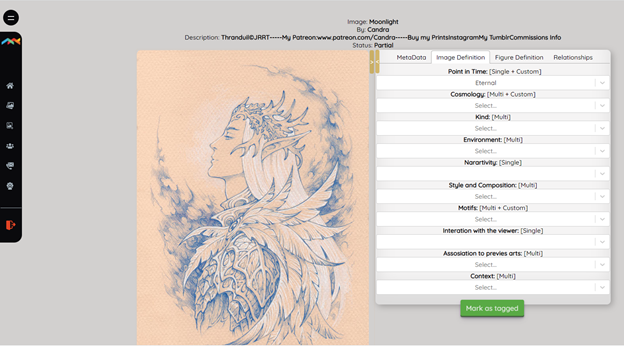Fantastic Art Master
Sharon Khalifa-Gueta#, Tomer Sagi, Tsvi Kuflik - Department of Information Systems
Moshe Lavee, Eliezer Baumgarten# - Department of Jewish History and Digital Humanities
Artificial Intelligence
Digital Humanities
Database Collection Grant 2021
 The digital project “Fantastic Art Master” was conceived to be able to accumulate and analyze the enormous amount of fantastic artworks and visual data in the Internet Arena. In the last two and a half decades a new existing on-line culture has started to form, that is the Fantastic-Art and Science Fiction culture (FASF). This culture is mostly studies as related to literature of those genres and also in relation to on- and off-line gaming scene, such as Dungeons and Dragons (D&D), miniature Warcraft games, computer games and on-line Internet virtual worlds games. Another aspect of this phenomena are festive gatherings, such as Comicon, and on-line websites of fens, such as Fandom. Because of the global exponential growth of this fan-culture, it is more than peculiar that the fandom’s artistic genre and scene has not yet received proper attention from the art history discipline. Moreover, the Fantastic art visual artistic genre was labeled with many stereotypes by art historians and curators, and has suffered from exclusion from both academic investigations and the GLAM (Galleries, Libraries and Museums) institutions, as it is claimed to be infantile, popular art, and titillated. Therefore, the incredible amount of knowledge regarding a global culture that has been developing in an on-line global arena was overlooked by the traditional fine-art discipline, and an understanding of the depth and fascinating artistic phenomena, actually ruling the artistic discourse on-line today, is essential for the understanding of today’s on-line global cultural arena. This project is a first step in analyzing this artistic genre while aiming to explain its dimensions, alongside exploring for a method in which such untouched land can be approached.
The digital project “Fantastic Art Master” was conceived to be able to accumulate and analyze the enormous amount of fantastic artworks and visual data in the Internet Arena. In the last two and a half decades a new existing on-line culture has started to form, that is the Fantastic-Art and Science Fiction culture (FASF). This culture is mostly studies as related to literature of those genres and also in relation to on- and off-line gaming scene, such as Dungeons and Dragons (D&D), miniature Warcraft games, computer games and on-line Internet virtual worlds games. Another aspect of this phenomena are festive gatherings, such as Comicon, and on-line websites of fens, such as Fandom. Because of the global exponential growth of this fan-culture, it is more than peculiar that the fandom’s artistic genre and scene has not yet received proper attention from the art history discipline. Moreover, the Fantastic art visual artistic genre was labeled with many stereotypes by art historians and curators, and has suffered from exclusion from both academic investigations and the GLAM (Galleries, Libraries and Museums) institutions, as it is claimed to be infantile, popular art, and titillated. Therefore, the incredible amount of knowledge regarding a global culture that has been developing in an on-line global arena was overlooked by the traditional fine-art discipline, and an understanding of the depth and fascinating artistic phenomena, actually ruling the artistic discourse on-line today, is essential for the understanding of today’s on-line global cultural arena. This project is a first step in analyzing this artistic genre while aiming to explain its dimensions, alongside exploring for a method in which such untouched land can be approached.
The first challenge that was confronted using the funds of this grant was the enormous amount of fantastic artworks on-line, for example, just the word “dragon” has 4.5 Million results on the fandom website deviantart, With the aid of Mutlaq Hijazi, Obaida Jabareen, and Einat Kovalyo, the website “Fantastic Art Master” for which over 53,000 images were collected from seven different websites to the google cloud and uploaded, alongside crowd sourcing tagging scheme was formed. This scheme was delicately conceived as an ontology, while juxtaposing two semiotic languages: the one is the art history dictionary – linked with the Getty’s Art & Architecture Thesaurus Online database, the other is the semiotic fantastic dictionary, inspired by the 5th edition of D&D rules manual – while the absent of an on-line ontology for this cultural language was detected. This tagging ontology also arose the interest of high-tech company tasq.ai, which decided to adopt a portion of the ontology into their tagging system and use their crowd sourcing resources to develop this project toward its next face of machine learning visual recognition.
This project arose the interest of many scholars around the world, such as Dr. Jacqueline Christmas from Exeter university, Dr. Carina Popovici the CEO of Art Recognition, and
Stacey Kalkowski from the United Arab Emirates University (UAEU). Dr. Khalifa-Gueta was also invited as a visiting scholar to University of Southern Denmark (SDU) by Prof. Rikke Schubart – a leading scholar in the fantastic in Media and the head of the imagining the impossible project.


